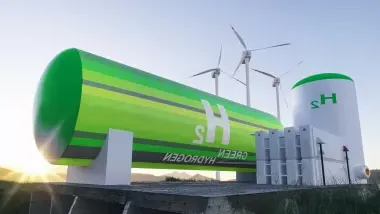
Podcast
ADIPEC 2023 - Transformative Hydrogen Projects
Over the last few years, the role of ammonia has evolved from being a key ingredient in the fertiliser industry and global food value chain, to a carbon-neutral transportable and dispatchable form of energy.
The projected worldwide population growth of two billion people by 20501 will mean demand for fertilisers will grow, but global carbon reduction targets will mean that production methods will themselves have to be decarbonised.
The war in Ukraine is putting further demand on the production of ammonia as Russia is a key exporter of fertilisers. Export sanctions are now forcing countries to plan new routes of supply. The clear roadmap is that this will increase demands for new fertiliser production in countries that previously imported and now strategically require local production. This scenario will also accelerate the need for expansion of hydrogen production technology which is key ingredient of ammonia.
Ammonia is also now seen as a carrier and supplier of hydrogen energy due to its higher (nearly three times) volumetric energy density (i.e. its ability to deliver energy) and its relative ease of storage at a much less energy-intensive –33 °C compared to –253 °C for liquid hydrogen. Another advantage is that ammonia movement can utilise existing well-established supply chains and infrastructure that have been available and proven for decades.
The core "grey" ammonia production process is still Haber-Bosch synthesis, a process developed over one hundred years ago in the first decade of the 20th century that combines nitrogen with hydrogen to produce ammonia, helped by iron as the catalyst.
The production of one of the two key components, hydrogen, can make the ammonia “blue” or “green” depending on the feedstock and production process. Blue low-carbon ammonia is essentially like conventional grey ammonia coupled with carbon capture, which can reduce its carbon emissions by more than 90%. Green ammonia uses green hydrogen produced by water electrolysis, powered by renewable energy, making green ammonia production virtually carbon dioxide–free.
Industries and countries committed to net-zero are moving towards blue and green ammonia as they emerge as strong candidates for long-term energy carriers, vectors providing a route for greenhouse gas emissions reduction as low- or zero-carbon fuels. For example, Japan is focussed on testing cofiring ammonia in coal-based power plants with the aim of converting entirely to ammonia in the future.
The market for blue and green ammonia is huge and according to the IEA, ammonia demand will grow by 25% by 20502. Consequently, Wood is involved in several studies and projects on blue and green ammonia and increasingly we are seeing lots of interest among our clients. We are working with ADNOC on the development of a world-scale blue ammonia production facility in Ruwais, Abu Dhabi. We are also supporting Horisont Energi with a broad suite of services under a framework agreement that covers the Barents Blue project, Europe’s first large-scale production facility for blue ammonia. Plus, on the green side we are involved in Total Eren's Magallanes project in Chile, where our knowledge will help to support the production of ammonia from green hydrogen at one of the largest such projects in the world.
Intense research and development is focusing on other uses for ammonia, establishing use of ammonia as fuel for internal combustion engines (vehicle engines), marine bunker fuel, fuel to gas turbines for power generators, direct ammonia fuel cells and also an advanced class gas turbine that is fuelled by 100% ammonia. Fertiliser companies are also gearing up towards blue and green ammonia manufacturing. Several large projects were announced last year, such as the first big green ammonia project in the US which will convert 20,000 tonnes per annum of conventional grey ammonia green by installing electrolysers.
Green ammonia projects are at present on a more modest scale since they are limited by electrolyser capacity and thus an order of magnitude smaller than a typical grey ammonia plant. By contrast, blue ammonia scale will be comparable to grey ammonia since it requires only retrofit of CO2 capture, already demonstrated at the required scale. Wood has supported a client with their steam methane reformer (SMR) to support ammonia production where they are separately importing a % of green H2. Green H2 cannot replace the grey but the offset means new operating conditions for SMR need to be considered. It is worth noticing that Wood’s next generation of SMR technology can achieve 95% CO2 emissions reduction, compared to a traditional hydrogen production plant. The technology applicable for both greenfield and brownfield projects, will reduce CAPEX and OPEX for operators while improving the environmental footprint and efficiency.
Ammonia will play a critical role in food security and the energy transition as part of a sustainable long-term energy mix given its many potential applications. Wood is perfectly placed to be part of the blue and green ammonia market, helping clients to shape and achieve their targets towards net-zero. As I have discussed, critical to achieve blue or green ammonia are carbon capture and storage (CCS) and green H2 from electrolysis respectively. As this technology develops, we aim to provide our wealth of knowledge on CCS and hydrogen to help shape the future for the production and use of ammonia.